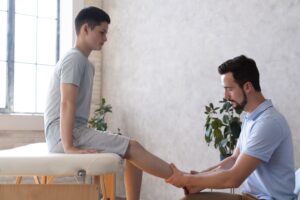Reflexology is generally safe, but certain conditions require caution or even avoidance to prevent complications. Those with active thrombosis, deep vein thrombosis, or pulmonary embolism should skip sessions due to the risk of dislodging clots. Open wounds, fractures, or severe nerve damage in the feet also demand careful assessment—pressure could worsen injuries.
Pregnant individuals, especially in initial stages, should consult a medical professional before trying reflexology, as some points may stimulate contractions. Even infections like athlete’s foot or eczema need attention; applying pressure on inflamed skin risks spreading irritation. Chronic illnesses—such as uncontrolled diabetes or severe circulatory issues—may/might require modified techniques or medical clearance.
Despite its relaxing benefits, reflexology isn’t one-size-fits-all, and being aware/knowledgeable of when to pause ensures/guarantees/secures safety. What else should someone consider before booking that appointment?
What is Reflexology Contraindications
Reflexology can be a relaxing way to support overall wellness, but it’s not for everyone. Certain health conditions, like blood clotting disorders or deep vein thrombosis, require caution—applying pressure could dislodge blood clots. Open wounds, infections, or ulcers on the feet are also contraindications, as reflexology might worsen them.
While the practice is generally gentle, those with nerve damage or recent foot injuries should avoid it. Temporary discomfort, fatigue, or emotional responses can occur, though these typically pass quickly. A trained reflexologist will assess individual needs, ensuring safety. It’s crucial to communicate any health concerns beforehand to avoid risks.
Whenever done carefully, reflexology remains a beneficial option for many—just not all. Apprehension of these limitations helps people make informed choices.
Pregnancy and Reflexology Safety
Is reflexology safe during pregnancy? While reflexology can offer relaxation, it requires caution during pregnancy due to potential risks. In the initial 12 weeks, reflexology could stimulate uterine contractions, so it’s best avoided unless performed by a therapist trained in maternity reflexology. Pregnant women should always consult their healthcare provider before starting sessions.
Later in pregnancy, techniques may need adjustments to guarantee safety. Reflexology isn’t universally unsafe, but medical clearance helps avoid complications. The key is open communication with a healthcare provider to weigh benefits and risks. Some practitioners specialize in pregnancy reflexology, using gentler methods. If approved, sessions should focus on comfort and avoid pressure points linked to labor induction. Safety first—always prioritize professional guidance.
Risks With Recent Foot Injuries or Surgery
Though foot reflexology can feel soothing, those with recent injuries or surgery should hold off until fully healed. Applying pressure to sensitive areas might disrupt healing or worsen inflammation, making it one of the certain contraindications for treatment.
Even gentle manipulation could irritate tissue, slow recovery, or affect blood flow to the affected area. Refrain from reflexology if stitches, swelling, or tenderness are present. Always consult a healthcare provider before resuming sessions after surgery, as timing varies.
Reflexologists should be informed of any recent procedures to preclude complications. Prioritizing rest and doctor-approved recovery steps guarantees safer, more effective sessions later. While reflexology offers benefits, patience with healing avoids unnecessary risks.
Circulatory and Blood Clot Concerns
People with circulatory issues or a history of blood clots should approach reflexology with caution, as the therapy’s effects on circulation could pose risks. While reflexology is generally safe, certain reflex points can stimulate blood flow, which could be problematic for those with clotting disorders or active thrombosis. Deep pressure techniques should be avoided, as they might dislodge a blood clot. Always consult a healthcare provider before proceeding if there’s a history of deep vein thrombosis (DVT) or embolism.
| Concern | Risk Level | Precautions |
|---|---|---|
| Active thrombosis | High | Avoid reflexology |
| History of DVT | Moderate | Light pressure only |
| Blood clotting disorders | Moderate | Medical clearance needed |
| Pulmonary embolism | High | Do not proceed |
| Poor circulation | Low | Monitor closely |
Therapy should be tailored to individual needs to guarantee safety.
Dealing With Foot Infections or Wounds
While handling foot infections, wounds, or recent injuries, reflexology demands extra care to avoid complications. Reflexology should be avoided when Open Wounds or infections are present, as pressure could exacerbate irritation or spread bacteria.
Clients with deep cuts, fungal infections, or surgical incisions should postpone treatment until fully healed. Similarly, those recuperating from Vein Thrombosis (DVT) or severe circulatory issues must refrain from reflexology on affected areas to prevent further risks.
A reflexologist will assess the client’s condition before proceeding and might modify techniques to avoid compromised areas. Neglecting these precautions can delay healing or introduce infections. It’s crucial to communicate openly with the reflexologist about any foot concerns to guarantee a safe and beneficial session.
Special Considerations for Chronic Illnesses
Chronic illnesses demand special attention while considering reflexology, as the therapy’s pressure techniques could interact with certain conditions. Certain health conditions require adjustments or contraindications to avoid complications, especially whenever reflexology stimulates key points in the body.
- Diabetes: Those with uncontrolled blood sugar should delay sessions, as reflexology might affect circulation and nerve sensitivity.
- Heart Conditions: Severe cardiovascular issues or pacemakers could not pair well with reflexology’s circulatory effects.
- Epilepsy: Deep relaxation might, in rare cases, lower seizure thresholds, so caution is advised.
- Active Infections or Fevers: Sessions should wait until recovery, as stimulating points could overwork an already stressed system.
Clients with chronic illnesses should consult a healthcare provider before booking, ensuring reflexology aligns with their needs. Timing and technique adjustments can make sessions safer for sensitive conditions.
Side Effects and Temporary Discomfort
Reflexology’s soothing techniques often bring relief, but they can also introduce mild side effects that fade quickly. Some people feel tenderness or minor discomfort during the session, especially in sensitive areas linked to problem organs.
Fatigue or drowsiness could follow as the body adapts to deep relaxation. Rare cases, like those with Deep Vein Thrombosis (DVT), might risk clot dislodgement due to pressure on affected areas—highlighting why sharing health history with the reflexologist is crucial.
While most reactions pass within hours, those with chronic conditions may notice temporary symptom flare-ups. Drinking water and resting help ease post-session effects. Open communication guarantees adjustments, minimizing risks while keeping sessions safe and comfortable. Always listen to the body’s signals.
Emotional Responses During Reflexology
Many people find reflexology deeply relaxing, but some sessions can also bring up unexpected emotions. The pressure applied during treatment can release stored tension, leading to emotional release as the body unwinds. This is a natural part of the process, but it could surprise those who associate reflexology only with physical relief.
Unexpected Feelings: Clients may experience sudden sadness, joy, or even tears as repressed emotions surface.
A Sign of Healing: Emotional release often indicates the body is letting go of stress, enhancing overall well-being.
Supportive Environment: A skilled reflexologist provides reassurance, helping clients process these reactions safely.
Preparation Helps: Knowing emotional shifts are possible allows clients to approach sessions with openness and less concern.
Communicating with the reflexologist beforehand can ensure a supportive environment, making the experience more comfortable. Emotional responses, though surprising, may lead to deeper healing.
When to Consult a Healthcare Provider Before Treatment
Why could someone need to check with their doctor before trying reflexology? While reflexology is generally considered safe and harmless for most people, certain conditions require a healthcare provider’s approval initially.
For instance, those under active medical care—like monitoring blood pressure or blood chemistry—should ensure reflexology aligns with their treatment plan. Open wounds, infections, or unknown rashes also warrant caution, as pressure on affected areas could exacerbate symptoms.
Severe swelling, inflammation, or conditions affecting lymph flow may also pose risks. Unidentified pain or gangrene could signal deeper issues needing attention before therapy. Consulting a doctor ensures safety and avoids unintended complications, especially when health is already delicate. It’s a simple step to confirm reflexology supports—rather than disrupts—well-being.
Conclusion
The warm press of a thumb along the arch, the gentle kneading of tired soles—reflexology soothes, but not without caution. Like a river avoiding jagged rocks, skilled hands navigate around wounds, fragile veins, or tender areas, ensuring safety dances with relief. For some, it’s a pause; for others, a modified rhythm. Always, it’s a conversation between client and healer, where listening becomes as crucial as touch.





